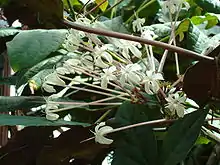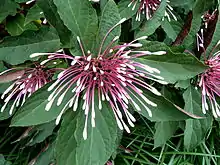Clerodendrum quadriloculare
Clerodendrum quadriloculare (known as the bronze-leaved clerodendrum, fireworks plant,[2][3] Philippine glorybower, shooting star or starburst bush[3] in English, and bagawak or bagawak morado[2][3] in Filipino) is a species of flowering plant native to New Guinea and the Philippines. It is one of many species previously included in the family Verbenaceae, but transferred to the Lamiaceae based on molecular studies.[4][5][6][7] The plants produce flowers which look good in a garden, but it can be difficult to eradicate.
| Clerodendrum quadriloculare | |
|---|---|
 | |
| Scientific classification | |
| Kingdom: | Plantae |
| Clade: | Tracheophytes |
| Clade: | Angiosperms |
| Clade: | Eudicots |
| Clade: | Asterids |
| Order: | Lamiales |
| Family: | Lamiaceae |
| Genus: | Clerodendrum |
| Species: | C. quadriloculare |
| Binomial name | |
| Clerodendrum quadriloculare | |
| Synonyms[1] | |
| |
Description
The bronze-leaved clerodendrum is a medium to large-sized shrub growing to a height of about 5 m (16 ft). The branches and twigs are four-sided. The leaves are in opposite pairs and are borne on medium-length petioles. The leaf blades are oblong and up to 20 cm (8 in) long, the upper surface being green and the underside purple; they have rounded bases, wavy margins and pointed tips. The showy flower clusters are borne at the tips of the shoots. Each contains many flowers with slender pink tubes about 7 cm (3 in) long, each terminated by five slender white, reflexed corolla lobes about 1.5 cm (0.6 in) long. The flowers are followed by ellipsoid, capsules containing four seeds.[8] The corolla tubes are exceptionally long and require specialist pollinators.[9]
Distribution and habitat
The bronze-leaved clerodendrum is native to the Philippines and Papua New Guinea, and has also been recorded from American Samoa, the Federated States of Micronesia, Fiji, French Polynesia, Guam, the Marshall Islands, the Northern Mariana Islands, Palau and Samoa, as well as Puerto Rico,[8] Singapore and Hawaii. As well as parks and gardens, it is found on road verges and on disturbed ground, pastures, forest edges and undisturbed forests where it is able to displace native species.[9]
Invasiveness
The bronze-leaved clerodendrum is grown as an ornamental shrub but it has become naturalised in many locations, in some of which it is viewed as an invasive species.[8] It is a vigorous, rapid-growing shrub which sends up suckers which may develop into thickets. Additionally, cuttings and pieces of detached roots are easily moved with soil and can develop into new plants, and the seeds, which germinate readily, are spread by animals and birds in their droppings.[8] This shrub can grow in full sun, partial shade and deep shade, and in some locations grows as a dense, mono-specific ground cover layer under the forest canopy.[9]
Uses
A leaf extract of the bronze-leaved clerodendrum has been used in traditional medicine for indigestion and to relieve abdominal pain. In a research study, the extract was found to be non-toxic and to cause relaxation of smooth muscle cells, with the effects being comparable to those resulting from the use of atropine, the standard treatment.[10]
 In bloom at the Fairchild Tropical Botanic Garden.
In bloom at the Fairchild Tropical Botanic Garden. Seedlings
Seedlings.jpg.webp) Close-up of a C. quadriculare flower
Close-up of a C. quadriculare flower
References
- "Clerodendrum quadriloculare (Blanco) Merr". Plants of the World Online. The Trustees of the Royal Botanic Gardens, Kew. n.d. Retrieved August 23, 2020.
- Rojo, Justo P. (1999). Revised Lexicon of Philippine Trees. Los Baños, Laguna, Philippines: Forest Products Research and Development Institute, Department of Science and Technology. ISBN 9716260024.
- Marciano, Marietta R., ed. (2012). Philippine Native Trees 101: Up Close and Personal. Green Convergence for Safe Food, Healthy Environment and Sustainable Economy, & Hortica Filipina Foundation, Inc. ISBN 978-971-95469-0-0.
- Kew World Checklist of Selected Plant Families
- Cantino, P.D., Harley, R.M. & Wagstaff, S.J. 1992. Genera of Labiatae: status and classification. Pp. 511–522. In: Raymond M. Harley and Tom Reynolds (editors). Advances in Labiate Science. Richmond, Royal Botanic Gardens, Kew.
- Wagstaff, Steven J.; Hickerson, Laura; Spangler, Russ; Reeves, Patrick A.; Olmstead, Richard G. (1998). "Phylogeny in Labiatae s. l., inferred from cpDNA sequences". Plant Systematics and Evolution. 209 (3–4): 265–274. doi:10.1007/BF00985232.
- Pacific Island Ecosystems at Risk
- Jackson, Grahame. "Fireworks: Clerodendrum quadriloculare". Pacific Pests, Pathogens & Weeds fact sheets. Australian Centre for International Agricultural Research. Retrieved 30 October 2020.
- Rojas-Sandoval, Julissa; Acevedo-Rodríguez, Pedro (21 September 2012). "Clerodendrum quadriloculare (bronze-leaved clerodendrum)". Invasive Species Compendium. CABI. Retrieved 30 October 2020.CS1 maint: multiple names: authors list (link)
- Jonatas-Tongol, K.A.S.; Ysrael, M.C. (2015). "The antispasmodic effect of Clerodendrum quadriloculare (Blanco) Merr. leaf extracts" (PDF). International Journal of Pharmacy. 5 (2): 536–540. ISSN 2249-1848.CS1 maint: multiple names: authors list (link)
External links
 Media related to Clerodendrum quadriloculare at Wikimedia Commons
Media related to Clerodendrum quadriloculare at Wikimedia Commons